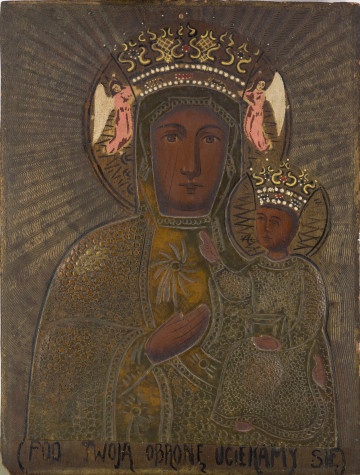
Madonna and Child with angels
1801 — 1900
National Museum in Lublin
Part of the collection: Folk Art of the Lublin Region (17th–1st half of the 20th c.)
Paintings on glass were usually produced locally, often in people's own cottages. The most remote rural settlements were reached by glassblowers that carried glass paintings and windowpanes in wooden constructions on their backs from cottage to cottage. Itinerant sellers acted as intermediaries between the makers of paintings and the buyers. They came from areas where glassworks existed (Bohemia, Moravia, Slovakia, Bavaria, Silesia), where in the second half of the 18th century workers of the glassworks with their families opened painting workshops for paintings on poorly-made broken glass panes. The paintings were intended to be sold at home. Although the craft was taught from generation to generation, the names of the painters are mostly forgotten. However, the painters became a permanent fixture in the provincial landscape of the time.
The sale of paintings of saints was often accompanied by a ceremony. Upon entering the room, the innkeepers would greet those present with the name of Christ, kneel in front of the paintings and pray aloud. Then they spread out the offered images, praising the effectiveness of prayers to individual saints. They also explained the content of the scenes in the paintings. After the transaction was completed, they would help hang the paintings in the farmer's chamber.
Peasants would also buy paintings at feasts and church fairs or during pilgrimages to ‘miraculous images’ or other holy places. From such trips, from local workshops, images of the Virgin Mary were often brought back. These included Our Lady of Częstochowa, symbolising the suffering of Pieta, and Our Lady of Sorrows, pierced by swords. One of the most frequently bought paintings was the representation of the Mother of God Feeding, also painted in Pokuttya, which was within the borders of the Republic of Poland until 1939.
The Pokuttya variety flourished in the second half of the 19th century. Iconographic themes were painted for both Catholics and Uniates. Among the paintings with a characteristic Orthodox-Byzantine form are, first of all, representations of St. Nicholas and the Mother of God the Protector, called Pokrovna. The Pokuttyan paintings were usually multi-thematic, strongly ornamented with various simplified or abstract floral forms. The artists used vivid colours, based mainly on combinations of pink, yellow, blue, green, red and white.
Author / creator
Dimensions
cały obiekt: height: 40 cm, width: 47 cm
Object type
picture
Material
glass, oil-based paint
Creation time / dating
Creation / finding place
Owner
The National Museum in Lublin
Identification number
Location / status

1801 — 1900
National Museum in Lublin

1890 — 1910
National Museum in Lublin

1801 — 1900
National Museum in Lublin
DISCOVER this TOPIC
National Museum in Lublin
DISCOVER this PATH
Educational path